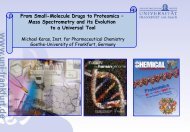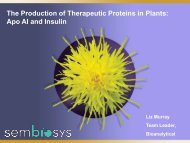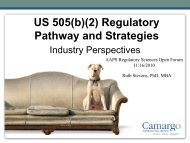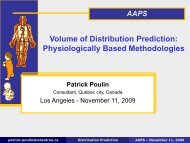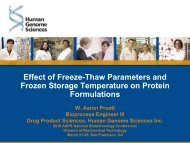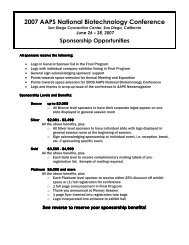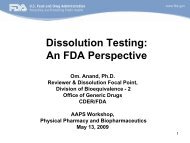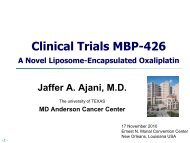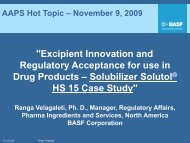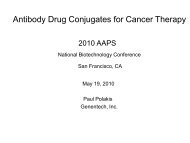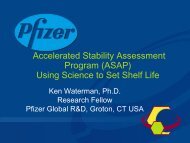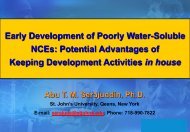Preliminary Program - American Association of Pharmaceutical ...
Preliminary Program - American Association of Pharmaceutical ...
Preliminary Program - American Association of Pharmaceutical ...
Create successful ePaper yourself
Turn your PDF publications into a flip-book with our unique Google optimized e-Paper software.
75<br />
2009 AAPS Annual Meeting and Exposition<br />
AAPS Pharmacokinetics, Pharmacodynamics and Drug Metabolism (PPDM) <strong>Program</strong>ming<br />
Clinical Pharmacology Rationale <strong>of</strong> First Time<br />
in Human Dosing Study<br />
Waldemar Radziszewski, M.D.<br />
Merck and Co., Inc.<br />
Regulatory Insight and Experience <strong>of</strong> First Time<br />
in Human Dosing Studies<br />
Mehul Mehta, Ph.D., invited<br />
U.S. Food and Drug Administration<br />
9:00 am – 11:00 am<br />
Predicting Oral Drug Absorption:<br />
Fiction and Facts<br />
Roundtable<br />
Finding a safe and effective compound amongst the<br />
hoards <strong>of</strong> available chemical moieties is challenging<br />
and costly. To bring a single drug to market may<br />
take years, cost hundreds <strong>of</strong> millions <strong>of</strong> dollars, and<br />
generally require testing in thousands <strong>of</strong> human<br />
subjects. Most drug candidates never make it as far<br />
as human testing and many that do are rejected for<br />
various reasons. In an effort to minimize time and<br />
costs <strong>of</strong> drug discovery and creation, pharmaceutical<br />
manufacturers have produced numerous screening<br />
techniques to identify the drug candidates most<br />
likely to take them to market. Some <strong>of</strong> these<br />
tests are aimed at drug absorption, distribution,<br />
metabolism, and elimination (ADME). Others<br />
are aimed at the effectiveness <strong>of</strong> drugs. In silico<br />
methods (i.e. computer models) are the fastest and<br />
one <strong>of</strong> the most efficient means for screening large<br />
numbers <strong>of</strong> drugs for oral absorption. For drugs<br />
that have survived the screening process, in silico<br />
methods continue to play an important role. This<br />
session will review models for predicting oral drug<br />
absorption.<br />
Moderators<br />
Lawrence X. Yu, Ph.D.<br />
U.S. Food and Drug Administration<br />
Tycho Heimbach, Ph.D., M.S.<br />
Novartis<br />
Mechanistic Approaches to Predicting Oral<br />
Drug Absorption<br />
Gordon Amidon, Ph.D.<br />
University <strong>of</strong> Michigan<br />
Roles <strong>of</strong> Oral Drug Absorption and Exposure<br />
Prediction in Drug Development<br />
Tycho Heimbach, Ph.D., M.S.<br />
Novartis<br />
Roles <strong>of</strong> Oral Drug Absorption Prediction in<br />
Regulatory Review<br />
Robert Lionberger, Ph.D.<br />
U.S. Food and Drug Administration<br />
9:00 am – 11:00 am<br />
Evaluating Fit-for-Purpose Models:<br />
Consensus or Controversy<br />
Roundtable<br />
Disease/PK/PD/Trial Models are now being<br />
increasingly used to aid decisions in industry,<br />
hospital, and regulatory settings. It is generally<br />
agreed that the adequacy <strong>of</strong> a model should be<br />
judged mainly based on its intended application.<br />
While modeling zealots continue to debate on<br />
what term best fits the process <strong>of</strong> evaluating model<br />
adequacy (model validation, model evaluation, etc.)<br />
the more critical issue is the lack <strong>of</strong> consensus on<br />
what constitutes an adequate model for a specific<br />
application. The objective <strong>of</strong> this roundtable is to<br />
debate on the appropriateness <strong>of</strong> models frequently<br />
used in 3 areas <strong>of</strong> drug development; models<br />
derived from in vitro, preclinical and literature<br />
(study-level) data on competitors to inform decisions<br />
in preclinical and clinical development, models<br />
used to select doses for Phase 3 testing, and models<br />
used for regulatory decisions, specifically to derive<br />
labeling statements. The overarching question<br />
is, what are the minimally acceptable statistical,<br />
biological, and predictive (S, B, P) properties <strong>of</strong><br />
such models? To encourage an interactive session<br />
on specific items, panel presentations will focus on<br />
the following scenarios <strong>of</strong> model application. First,<br />
intended application using exposure-response<br />
models for efficacy and safety to design a dose<br />
response study to find optimal dose(s) for Phase<br />
3 testing. What are minimally acceptable S/B/P<br />
properties for such models? What visual and<br />
statistical tools would you use to judge model<br />
adequacy? Second, intended application benchmark<br />
the magnitude <strong>of</strong> efficacy <strong>of</strong> your compound relative<br />
to competitors based on literature data to make a<br />
go/no-go decision. What are minimally acceptable<br />
S/B/P properties for such a model that combines<br />
subject level data for your compound with study<br />
level data with competitors? What visual and<br />
statistical tools would you use to judge model<br />
adequacy? Finally, intended application labeling<br />
statement to include the estimated magnitude <strong>of</strong><br />
mean change in PK/efficacy/safety under conditions<br />
<strong>of</strong> an interacting agent or in a special population.<br />
What are minimally acceptable S/B/P properties for<br />
such models? What visual and statistical tools would<br />
you use to judge model adequacy?<br />
Moderator<br />
Sriram Krishnaswami, Ph.D.<br />
Pfizer Global Research & Development<br />
A Pharmacologist’s View<br />
Nick Holford, M.D., M.S.<br />
University <strong>of</strong> Auckland<br />
A Statistician’s View<br />
Kenneth Kowalski, M.S.<br />
A2PG<br />
A Regulator’s View<br />
Yaning Wang, Ph.D., invited<br />
U.S. Food and Drug Administration<br />
OPEN FORUM<br />
1:30 pm – 5:00 pm<br />
An Evolution or Revolution in Drug<br />
Metabolism: When, Where, Why,<br />
What, How?<br />
AAPS Pharmacokinetics, Pharmacodynamics<br />
and Drug Metabolism (PPDM) Open Forum<br />
An additional fee is required to attend this open forum<br />
The critical aspects and fundamentals for<br />
understanding the metabolism <strong>of</strong> new drugs are in<br />
continual change driven by technological innovation,<br />
regulatory expectations and the ubiquitous<br />
pressures <strong>of</strong> logistics, timing, and cost. Because <strong>of</strong><br />
the diversity <strong>of</strong> different platforms and development<br />
programs, it is impossible to adopt a “one-size-fitsall”<br />
strategy for metabolism studies. Every molecule<br />
has unique characteristics and the development<br />
process represents complex and difficult challenges<br />
that pivot around the drug’s potency, efficacy, safety,<br />
toxicity, metabolic pathways and routes <strong>of</strong> excretion.<br />
Even greater challenges are poised on the horizon<br />
as human genomics and a deeper understanding<br />
<strong>of</strong> the impact <strong>of</strong> metabolic enzyme and transporter<br />
systems magnify the potential research complexity<br />
for metabolism studies. Technology is friend and<br />
foe providing incredible tools that facilitate greater<br />
sensitivity for metabolite identification but creating<br />
the difficult challenge <strong>of</strong> putting a meaningful<br />
perspective on the findings and observations.<br />
The questions that encapsulate drug metabolism<br />
studies are numerous and <strong>of</strong>ten escape any simple<br />
answer. At the PPDM Open Forum participants will<br />
discuss various aspects <strong>of</strong> the design, conduct<br />
and regulatory utility <strong>of</strong> mass balance and drug<br />
metabolism studies. Among the issues to be<br />
debated and discussed are: When is it best to<br />
perform human metabolism studies? Where will<br />
the greater understanding <strong>of</strong> human genomics<br />
take the next generation <strong>of</strong> metabolism studies?<br />
Why should samples be pooled or not and is there<br />
an optimal approach? What exactly is a “major”<br />
metabolite? How can 14C-tracer multiple dose study<br />
be conducted most efficiently and should they be?



